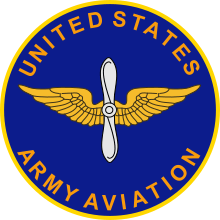United States Army Aviation Center of Excellence
The U.S. Army Aviation Center of Excellence, previously the Army Aviation Center and School, is the United States Army Aviation Branch's training and development center, located at Fort Rucker, Alabama. It "trains military, civilian, and international personnel in leadership skills [and] integrates aviation warfighting doctrine and requirements determination across the DOTMLPF"[1] Its Commanding General is Major General David J. Francis.[2]
| U.S. Army Aviation Center of Excellence | |
|---|---|
 | |
| Active | 2006- |
| Country | United States |
| Role | Training and Development |
| Garrison/HQ | Fort Rucker, Alabama |
The Center of Excellence includes three aviation brigades, the 1st Aviation Brigade, 110th Aviation Brigade, and 128th Aviation Brigade, and a Noncommissioned Officers' Academy.
History

Most training of pilots and mechanics for World War II Army Aviators was conducted by the Department of Air Training within the Field Artillery School at Henry Post Army Airfield, Okla., although the Army Air Forces conducted some primary training of Army Aviation personnel. During the Korean War, the Department of Air Training at Post Field expanded, and in early 1953, it became the Army Aviation School. As a result of the expansion of both aviation and artillery training, Post Field became overcrowded, and the Army decided to move the Army Aviation School to a different post. When no satisfactory permanent Army post was found, a temporary post, Camp Rucker, Ala., was chosen. The Army Aviation School began moving to Alabama in August 1954 and the first class began at Rucker in October.
On 1 February 1955, the Army Aviation Center was officially established at Rucker. In October of that year, the post was given permanent status with the name change from Camp Rucker to Fort Rucker. Before the mid-1950s, the Air Force had provided primary training for Army Aviation pilots and mechanics. In 1956, the U.S. Department of Defense gave the Army control over all of its own training. Gary and Wolters Air Force Bases in Texas, where the Air Force had been conducting this training, were also transferred to the Army. Lacking adequate facilities at Fort Rucker, Army Aviation continued primary fixed-wing training at Camp Gary until 1959 and primary rotary-wing training at Fort Wolters until 1973.
The pioneer African American flying instructor Milton Crenchaw taught at then-Camp Rucker from 1954 to 1966.
In 1956, the Army Aviation Center began assembling and testing weapons on helicopters. These tests, conducted while the Air Force still theoretically had exclusive responsibility for aerial fire support, led to the development of armament systems for Army helicopters.
The 2005 Base Realignment and Closure Commission recommended that Aviation logistics establishments at Fort Eustis be consolidated with the Aviation Center and School at Fort Rucker, although this did not take place. What had become the U.S. Army Aviation Warfighting Center was subsequently renamed the U.S. Army Aviation Center of Excellence on 26 June 2006.
Command and Directorates
The 1st Aviation Brigade is based here.
The Unmanned Aerial Systems Center of Excellence (UAS CoE), as the U.S. Army UAS Proponent’s principle management agency, provides intensive, centralized total capacity management and Unmanned Aerial System integration. The CoE coordinates with all Army institutional and operational organizations, Joint and other DoD agencies as required, to achieve a coherent and sustainable UAS strategy fostering the development of relevant and responsive concepts for current, emerging and future UAS interoperability with all manned and unmanned platforms.[3]
The UAS CoE mission statement is to provide: “integration and coordination with all Army organizations, the joint services, and other Defense Department agencies to achieve the U.S. Army UAS strategy that includes concepts for current, emerging and future UAS interoperability with all manned and unmanned systems.”[4]
The 110th Aviation Brigade consists of four battalions using three different sites. 1st Battalion, 11th Aviation Regiment, operates and manages air traffic control services for USAACe/Fort Rucker and the National Airspace System. 1st Battalion, 14th Aviation Regiment operates from Hanchey Army Heliport and conducts graduate level training using the AH-64 Apache attack helicopter. 1st Battalion, 212th Aviation Regiment operates from Lowe Army Heliport and Shell Army Heliport and conducts combat and night operational training, using OH-58 Kiowa, UH-1 Iroquois, and UH-60 Blackhawk helicopters. 1st Battalion, 223d Aviation Regiment operates from Cairns Army Airfield and Knox Army Heliport and conducts flight training using the CH-47 Chinook helicopter and C-12 Huron aircraft.
Training
At the Center students both learn to fly and also to employ aviation assets to assist United States forces with the 110th Aviation Brigade. Students usually spend 15–18 months in aviation school, learning a wide range of subjects, and finally graduating with their "wings" or Aviator's Badge. When second lieutenants arrive at Fort Rucker after graduating from their commissioning source (USMA, ROTC or OCS) they secure housing, they attend the two-month Basic Officer Leadership Course (BOLC) at Fort Rucker. Upon completion, they join the rest of their classmates, usually junior Warrant Officers, many of whom have previous enlisted experience.
Before starting academics, students must complete Dunker training and Army SERE (Survival, Evasion, Resistance and Escape) school. After SERE, students transition to Initial Entry Rotary Wing Aeromedical Training, or "aeromed" at the U.S. Army School of Aviation Medicine, where they learn subjects pertaining to flight and the human body. The information taught in these classes is tested frequently by instructor pilots (IPs) throughout flight school. Flight training varies by student and aircraft type, but in general students will complete Basic flight training, Instrument flight training and basic combat skills training. Students are taught the basics of flight as well as instrument flight in a TH-67 Bell Jetranger aircraft. Basic Combat skills training is taught in an OH-58.
See also
- Allen M. Burdett, Jr., commanded the 1st Aviation Brigade from 1969 to 1970 and Commanded the Army's Aviation Center of Excellence from 1970 to 1973.
References
- "Fort Rucker". Retrieved 8 February 2019.
- "Commanding General USAACE and Fort Rucker" Retrieved on 7 July 2019.
- http://www.ausa.org/publications/armymagazine/archive/january2010/Documents/Carlile.pdf%5B%5D
- "U.S. Army Aviation Center of Excellence and Fort Rucker: The Home of Army Aviation" (PDF). Archived from the original (PDF) on 16 February 2010. Retrieved 12 March 2010.
Further reading
- Lieutenant General John J. Tolson, Vietnam Studies: Airmobility 1961-1971, Department of the Army, WASHINGTON, D. C., 1973 (re-released 1989), Library of Congress Catalog Card Number 72-600371, First Printed 1973-CMH Pub 90-4
